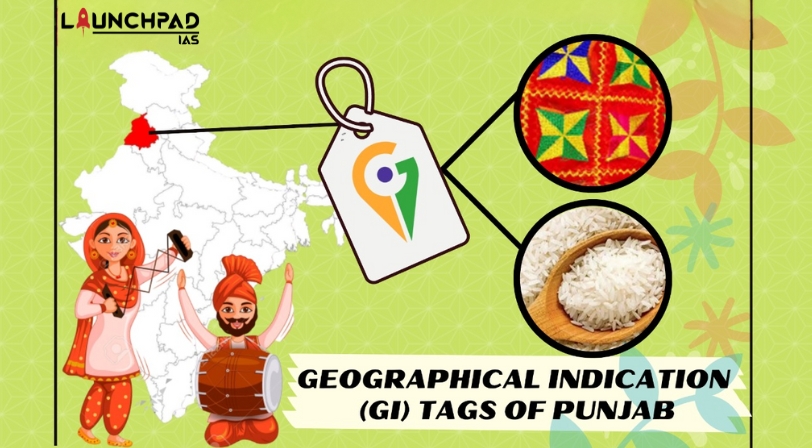What is a GI Tag?
- A Geographical Indication (GI) is a sign used on products that have a specific geographical origin and possess qualities or a reputation that are due to that origin.
- In addition, the qualities, characteristics, or reputation of the product should be essentially due to the place of origin.
- A geographical indication right enables those who have the right to use the indication to prevent its use by a third party whose product does not conform to the applicable standards.
- GI tag in India:
- Geographical Indications of Goods (Registration & Protection) Act, 1999 governs the GI tag in India.
- It is issued by the Geographical Indications Registry (Chennai).
- Products Covered: Agricultural products, foodstuffs, wine and spirit drinks, handicrafts, and industrial products.
- Tenure: Geographical indications registered as collective and certification marks are generally protected for renewable ten-year periods.
Benefits of GI Tag
- Prevents unauthorized use of a Registered Geographical Indication by others.
- It provides legal protection to Indian Geographical Indications which in turn boost exports.
- It promotes the economic prosperity of producers of goods produced in a geographical territory.
GI TAGS OF PUNJAB
PHULKARI
- Phulkari- a type of handicraft for which Punjab got its Geographical Indication on 21st October 2010. This GI tag is relevant- first for Punjab but will also make the work that is done in the states of Haryana and Rajasthan relevant as well.
- After 5 years of legal battle, Punjab Small Scale Industries & Export Corporation Ltd. was able to attain the title of GI tag for the traditional embroidery practiced by the women.
- The word PHULKARI means embroidery that contains intricate floral patterns combined with congruous colors. It is traditionally stitched on khaddar although, it is also done on silk, crapes, chiffon, and other fabrics.
- The handicraft derives its uniqueness from the specification in the measurement of the stitch that lies between 1/2 cm to 1/4 inch. The geometrical floral pattern is made by sewing straight lines, making them easily distinguishable from the other forms of embroidery.
- Phulkari is considered to be a symbol of festivity and auspiciousness by the people of the state. Various types of phulkaris exist like bagh, Sheesha Bagh, Ghunghat bagh, Darshan Dwar Bagh, etc. Each kind of bagh is used in a different ceremony or festivity. No wedding in Punjab is complete without seeing tall jattis draped in the Phulkaris. This pattern is now seen on salwars, jackets, and bags as well.
BASMATI RICE
- BASMATI is special long-grain aromatic rice grown and produced in a particular geographical region (namely Punjab, Haryana, Himachal Pradesh, Delhi, Uttarakhand, Uttar Pradesh, and Jammu & Kashmir) of the Indian sub-continent.
- The name BASMATI IS DERIVED FROM TWO SANSKRIT ROOTS ‘Vas’ meaning ‘aroma’ and ‘Mati’ meaning ‘ingrained from the origin’. Essentially, BASMATI means, ‘the one containing aroma’.
- BASMATI is nature’s gift and farmers have been growing this scented rice variety for many centuries. In India, various types of aromatic rice including short and long grains are grown. However, BASMATI is the best known among these owing to its many unique cooking and eating properties attributable to the agro-climatic conditions prevailing in the aforesaid geographical area.
- BASMATI rice varieties require prolonged sunshine, high humidity, cool weather during grain filling, sufficient water supply, and normal soil.
- The supremacy of BASMATI rice over other varieties of scented and non-scented rice is attributable to its unique and delicately balanced combination of several unique characteristics such as long slender kernels with a high length breadth ratio, an exquisite aroma, sweet taste, soft texture, delicate curvature, intermediate amylase content, high integrity of grain on cooking, and linear kernel elongation with least breadth wise swelling on cooking.
- These unique characteristics are attributable to the various natural and human factors involved in the sowing, harvesting, and processing of BASMATI rice.
How is a Geographical Indication Different from a Trademark?
- A trademark is a sign that is used in the course of trade, and it distinguishes the goods or services of one enterprise from those of other enterprises.
- Whereas a geographical indication is an indication used to identify goods having special characteristics originating from a definite geographical territory.


